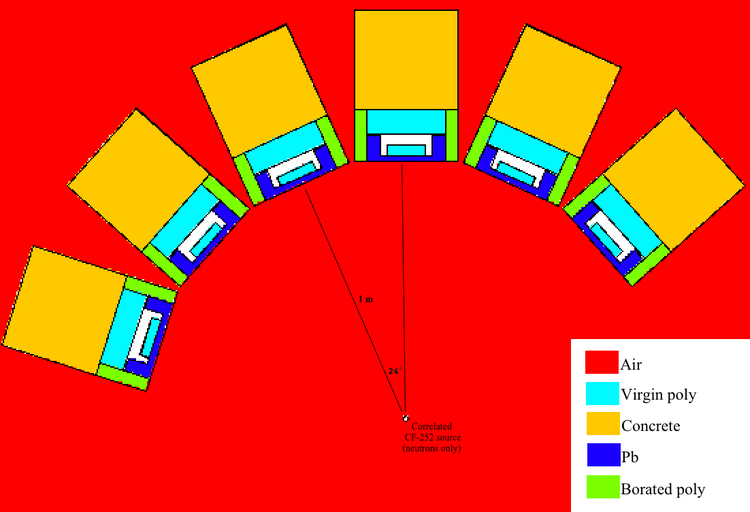Difference between revisions of "CrossTalk"
| Line 6: | Line 6: | ||
[[File:GeomEdited.png|750 px]] | [[File:GeomEdited.png|750 px]] | ||
| + | =Detector physics= | ||
| + | ==Summary== | ||
| + | Neutron energy deposition from collisions with hydrogen and carbon are converted to electron equivalent light output by MCNP-POLIMI. Neutron collisions occurring over a pulse collection time window of 10 ns are converted to MeVee and summed. When pulse's total light output exceeds 0.3 MeVee, it is considered a detection. The value 0.03 MeVee was chosen as the detector's light output threshold because it corresponds to a mean neutron energy deposit of 0.2 MeV. | ||
| + | |||
| + | |||
| + | The electron equivalent (MeVee) conversion functions for neutrons were measured for plastic (BC 420) scintillators as a function of neutron energy deposit, <math>E_{n}</math>. For deposit on hydrogen the measurements fit the following quadratic function: | ||
| + | |||
| + | <math>L=0.036E_{n}^{2}+0.125E_{n}</math> | ||
| + | |||
| + | and for deposit on carbon: | ||
| + | |||
| + | <math>L=0.02E_{n}</math> | ||
| + | |||
| + | A light output of 0.03 MeVee corresponded to an average neutron energy deposition of 0.2 MeV in the scintillator. | ||
Go back [[MCNP simulations]] | Go back [[MCNP simulations]] | ||
Revision as of 21:32, 18 July 2016
Go back MCNP simulations
Geometry
An array of 6 detectors are placed radially at a distance of 1 meter from an uncorrelated 252-CF source. The image below shows a top down view of the simulation geometry. The detector setups have a vertical extent of 30".
Detector physics
Summary
Neutron energy deposition from collisions with hydrogen and carbon are converted to electron equivalent light output by MCNP-POLIMI. Neutron collisions occurring over a pulse collection time window of 10 ns are converted to MeVee and summed. When pulse's total light output exceeds 0.3 MeVee, it is considered a detection. The value 0.03 MeVee was chosen as the detector's light output threshold because it corresponds to a mean neutron energy deposit of 0.2 MeV.
The electron equivalent (MeVee) conversion functions for neutrons were measured for plastic (BC 420) scintillators as a function of neutron energy deposit, . For deposit on hydrogen the measurements fit the following quadratic function:
and for deposit on carbon:
A light output of 0.03 MeVee corresponded to an average neutron energy deposition of 0.2 MeV in the scintillator.
Go back MCNP simulations
